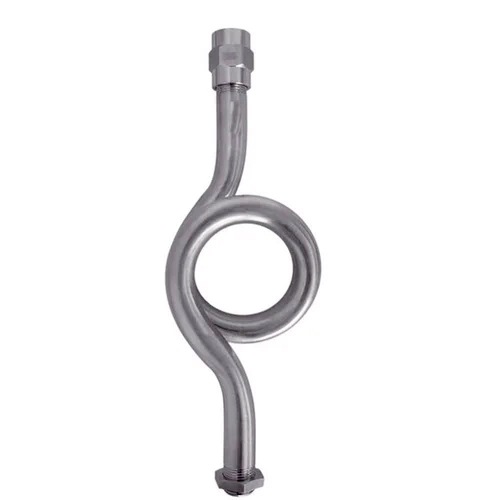Instrument Gauge Tubes - Siphon Tubes
A pressure gauge siphon
tube, also known as a pressure gauge pigtail, is a device installed to protect
the gauge from high temperatures. Siphons are used in hot vapor applications
and are particularly common on steam systems.
These systems are important
for monitoring vapor pressure for end-point use and generation in kettles.
However, a problem arises because the high steam temperature at typical
industrial pressures can damage the pressure sensor if connected directly.
1. Types of Siphon
tubes:
1.1
U-Tube Siphon
- Function: U-tube siphon tubes are shaped like a 'U' and
are designed to trap condensate, creating a barrier between the hot steam
and the pressure gauge.
- Pros: Good at preventing high-temperature steam from
reaching the pressure instrument. Compact and straightforward design.
- Cons: Might not provide as much cooling as coil siphon
tubes.
- Applications: Typically used in steam heating systems, boiler systems, and various industrial applications where space is limited.
1.2
Coil Siphon Tube
o Function: Coil siphon tubes are wound into a helical or spiral
shape. They allow the steam or hot fluid to cool down before reaching the
pressure gauge or sensor.
o Pros: Effective at cooling the fluid, preventing damage to
the instrument. Suitable for high-temperature applications.
o Cons: Can be bulky and require more space for installation.
o Applications: Used in steam boilers, industrial steam systems, and
high-temperature chemical processes.
1.3
Pigtail Siphon Tube
o Function: Pigtail siphon tubes are shaped like a loop or pig’s
tail. They trap condensate, which acts as a barrier between the hot steam and
the pressure gauge.
o Pros: Compact and easy to install. Effective in protecting
gauges from high-temperature steam.
o Cons: Less cooling capability compared to coil siphons.
o Applications: Commonly used in steam heating systems, boilers, and
other steam-driven equipment.
2.
Functions of
Siphon Tubes
- Protection: Siphon tubes protect pressure instruments from
high-temperature steam or fluids by cooling them down or creating a
condensate barrier.
- Pressure Measurement: They
enable accurate pressure measurement by preventing direct contact of
high-temperature fluids with the sensing element.
- Safety: Siphon tubes enhance safety by preventing damage
to sensitive instruments, which could lead to system failures.
3.
Pros and Cons
of Siphon Tubes
- Pros:
- Temperature Control: They
effectively reduce the temperature of steam or hot fluids before they
reach pressure gauges.
- Instrument Protection: They
prevent damage to pressure instruments, extending their lifespan.
- Safety: They contribute to the safe operation of
industrial systems by maintaining the integrity of pressure measurements.
- Cons:
- Space Requirements: Some
types, like coil siphon tubes, require more space for installation.
- Maintenance: Siphon
tubes may need regular maintenance to ensure they are free from blockages
or buildup.
- Cooling Limitations: Straight
siphon tubes offer limited cooling, making them unsuitable for very
high-temperature applications.
4.
Applications
- Steam Boilers: Siphon tubes are widely used
in steam boilers to protect pressure gauges from direct contact with
high-temperature steam.
- Industrial Steam Systems: They are
employed in various industrial steam systems to ensure accurate pressure
measurements and instrument protection.
- Chemical Processes: In
chemical industries, siphon tubes protect instruments from
high-temperature chemical reactants.
- Heating Systems: Used in steam heating systems
to safeguard pressure instruments from hot steam.
By using siphon tubes, industries can ensure the
reliable and safe operation of their pressure measurement instruments in
high-temperature environments.






No comments